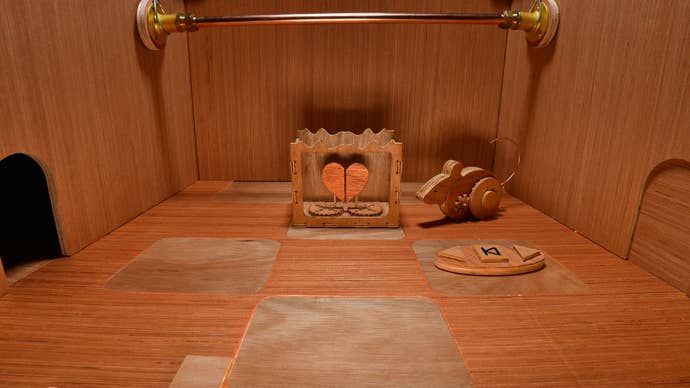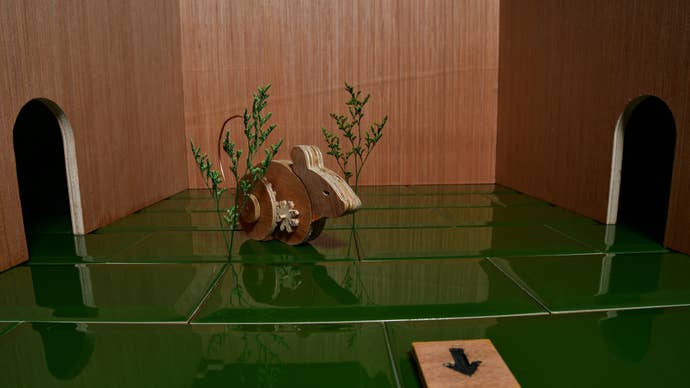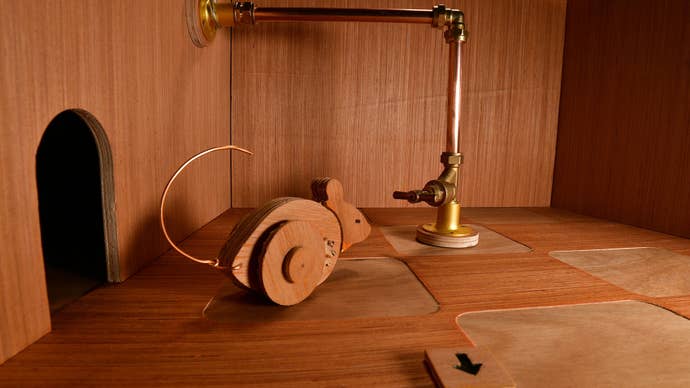Today sees the release of Éalú, a point-and-click puzzler about a wooden mouse exploring a maze. It’s a lovely-looking thing – a “true stop-motion game”, as the Steam page puts it, with every frame of animation based on photography of physical props and sets. After watching the trailer, it’s no huge surprise to learn that designer, animator and writer Ivan Fisher-Owen has a wider background in puppet-making and gadgetry. He and his partner Dr Emma Fisher-Owen run Beyond the Bark, an inclusive theatrical fabrication company based in Limerick, Ireland (“éalú” is an Irish word for “escape”).
Backstage know-how aside, Éalú draws upon Ivan Fisher-Owen’s misgivings about the brain-souring effects of being terminally online, with some interesting metaphors for everyday hellsite routines I will try my best not to baldly unpack. I listed Éalú in this week’s Maw round-up, and Fisher-Owen got in touch with me afterward to share code and chat briefly about the project’s guiding anxieties.
“The idea for Éalú came while I was thinking about how little I really understand the algorithms shaping my daily life,” he began, “and how they might be creating repetitive, potentially harmful loops I don’t even notice. The mouse in the maze grew out of that thought and the game as a whole is an expression of a stream of ideas stemming from that.”
The game’s cogwork models and perceptibly splintery, hand-made environments are a calculated reflection of Fisher-Owen’s ignorance about the actual workings of digital platforms. “When I sketched the concept for Éalú out onto paper,” he goes on, “the entire maze & its puzzles for me became, holistically, an expression of my experiences/fears/fascinations interacting with algorithm driven apps as a layman who doesn’t really understand how they work under the hood.”


Guiding Éalú’s mouse makes me feel at once protective and a bit exposed. Fisher-Owen summarises the critter as on one level, “a silent, nameless, genderless” blank tablet who is meant to inspire empathy, and on another, a “mirror” for “an inner world we intuitively want to protect when we’re browsing about online.”
The maze, meanwhile, may seem straightforward in terms of its puzzles and threats, but Fisher-Owen suggests that players will be gradually wrong-footed by it. “As you start to guide the little mouse through this maze, and obvious patterns emerge, rooms and areas within the maze start to clearly telegraph their either positive or sinister nature,” he comments. “But what also starts to occur is that things the player first is confused by or wants to actively avoid… may turn into dark or fruitless behaviors that they actively make the mouse engage in as they’re enticed by the curiosity of satisfying a goal, even if the goal is made to look like a dark place.”
It’s hard to go into further detail here without spoilers, but suffice it to say that you might recognise the visual language from your time at the internet’s coalface. There are various counters, including a tally of the mouse’s deaths, which have a bearing on spaces within the maze, and which may form a sort of doomscroll of negative reinforcement.

It seems necessary to spell out that Éalú does have a happy ending, though it might take you a couple of tries to reach it (the devs estimate that the game is 2-5 hours long). “At the end of the day, I wanted this weird little world to end with an expression of optimism that there’s a pathway to accessing what’s really nice about our digital age while maintaining our connection to each other and nature,” Fisher-Owen says. He also encourages players to disregard his inspirations and read Éalú against the grain, comparing it to a “silent film” that can be interpreted any number of ways.
Éalú is the work of four people in total. Fisher-Owen created the props and animations in his garden shed, with collaborator developer Benjamin Orr then translating the resulting 512 or so video clips into Unity, while handling other aspects of the game design and writing. JT Paton worked on original illustrations and promotional art, and Will Wood composed and recorded the score. You can read more on Steam. If you escape the maze and find yourself hankering for more hand-crafted props, I can only nudge you toward the labyrinths of Jack King-Spooner.